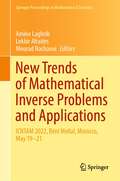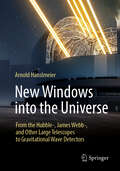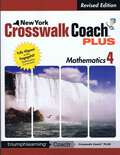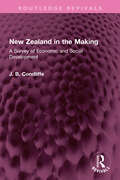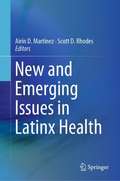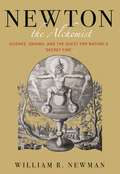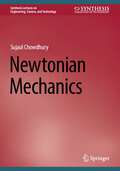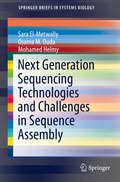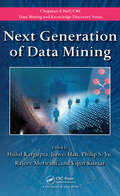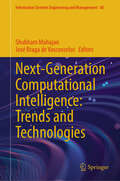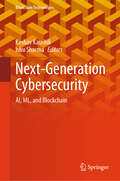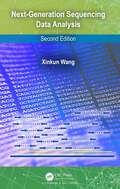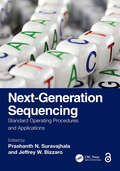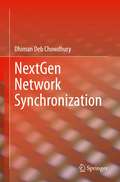- Table View
- List View
New Trends of Mathematical Inverse Problems and Applications: ICNTAM 2022, Béni Mellal, Morocco, May 19–21 (Springer Proceedings in Mathematics & Statistics #428)
by Amine Laghrib Lekbir Afraites Mourad NachaouiThis volume comprises the thoroughly reviewed and revised papers of the First International Conference on New Trends in Applied Mathematics, ICNTAM 2022, which took place in Béni Mellal, Morocco, 19-21 May 2022.The papers deal with the following topics: Inverse Problems, Partial Differential Equations, Mathematical Control, Numerical Analysis and Computer Science. The main interest is in recent trends on Inverse Problems analysis and real applications in Computer Science. The latter is viewed as a dynamic branch on the interface of mathematics and related fields, that has been growing rapidly over the past several decades. However, its mathematical analysis and interpretation still not well-detailed and needs much more clarifications. The main contribution of this book is to give some sufficient mathematical content with expressive results and accurate applications. As a growing field, it is gaining a lot of attention both in media as well as in the industry world, which will attract the interest of readers from different scientist discipline.
New Trends of Research in Ontologies and Lexical Resources
by Eduard Hovy Alessandro Oltramari Piek Vossen Lu QinIn order to exchange knowledge, humans need to share a common lexicon of words as well as to access the world models underlying that lexicon. What is a natural process for a human turns out to be an extremely hard task for a machine: computers can't represent knowledge as effectively as humans do, which hampers, for example, meaning disambiguation and communication. Applied ontologies and NLP have been developed to face these challenges. Integrating ontologies with (possibly multilingual) lexical resources is an essential requirement to make human language understandable by machines, and also to enable interoperability and computability across information systems and, ultimately, in the Web. This book explores recent advances in the integration of ontologies and lexical resources, including questions such as building the required infrastructure (e.g., the Semantic Web) and different formalisms, methods and platforms for eliciting, analyzing and encoding knowledge contents (e.g., multimedia, emotions, events, etc.). The contributors look towards next-generation technologies, shifting the focus from the state of the art to the future of Ontologies and Lexical Resources. This work will be of interest to research scientists, graduate students, and professionals in the fields of knowledge engineering, computational linguistics, and semantic technologies.
New Windows into the Universe: From the Hubble-, James Webb-, and Other Large Telescopes to Gravitational Wave Detectors
by Arnold HanslmeierThe observation capabilities of modern astrophysics are constantly increasing. They range from optical telescopes and space telescopes in the infrared to radio telescopes, and from gravitational wave detectors to neutrino observatories. While some focus on light in space, others examine the smallest particles underwater or measure disturbances in spacetime smaller than the diameter of a proton. This book offers an exciting and comprehensive overview of our technical capabilities to explore the universe. It is just as suitable as a foundation for a lecture in astronomy or astrophysics as it is for reading by those interested in the natural sciences.
New York Crosswalk Coach PLUS for the Common Core Learning Standards
by Triumph Learning Andie LiaoNew York Crosswalk Coach PLUS, Revised Edition provides an easy yet thorough approach to reviewing and practicing the skills covered in the CCLS. <p><p>Following the proven Coach format, this comprehensive resource provides scaffolded lesson practice for students to prepare them for the rigor of the state assessment. Pair New York Crosswalk Coach PLUS, Revised with New York Coach Practice Tests to prepare students for success!
New York Math Your Common Core Edition: Grade 6, Volume 1 (NY-CCLS)
by McGraw-Hill EducationGlencoe Math, focuses on four critical areas: (1) using concepts of ratio and rate to solve problems; (2) understanding division of fractions; (3) using expressions and equations; and (4) understanding of statistical reasoning.
New York State Test Prep: 6th Grade Math Practice Workbook
by Lumos LearningThis book is designed to help students get New York State Test (NYST) rehearsal along with standards aligned rigorous skills practice. Unlike a traditional book, this Lumos tedBook offers two full-length practice tests online.
New Zealand in the Making: A Survey of Economic and Social Development (Routledge Revivals)
by J. B. CondliffeFirst published in 1930, New Zealand in the Making is an economic history of the democratic experiments in New Zealand. The geography, population, government ownership of public utilities, compulsory arbitration, pensions and all other factors have been covered in detail. The book will be of interest to anyone keen on learning about New Zealand as well as to students of economy, history, agriculture, and government.
New and Emerging Issues in Latinx Health
by Scott D. Rhodes Airín D. MartínezThis volume is being published at a critical time in U.S. history and serves as a comprehensive and much-needed update to what is known about Latinx health. As both the United States and Latinx subgroups experience demographic shifts, it is critical to examine the current epidemiology of Latinx health, as well as the factors influencing the health and well-being of this growing population.Chapters in this book, written by highly respected experts, illuminate the diversity of the Latinx population and provide strategies to mitigate many of the challenges they face, including challenges related to migrating to new destinations. The book is designed to enrich dialogue around the multilevel determinants of Latinx health and concludes with a call to action for increased culturally congruent, theoretically informed and participatory Latinx health research. The book also encourages the mentorship and growth of early career and junior investigators to conduct research on Latinx health issues.A selection of the perspectives included among the chapters: Chronic disease and mental health issues in Latinx populationsSubstance use among Latinx adolescents in the United StatesPhysical and intellectual and developmental disabilities in Latinx populationsHealth insurance reform and the Latinx populationImmigration enforcement policies and Latinx healthResearch priorities for Latinx sexual and gender minoritiesRacial and ethnic discrimination, intersectionality, acculturation, and Latinx health New and Emerging Issues in Latinx Health is an invaluable compendium that provides a foundation of understanding Latinx health and well-being and guides future research and practice. The book is essential for researchers, practitioners, and students in the fields of public health and the social sciences including community and health psychology, health administration and policy, community health education, medical anthropology, medical sociology, population health, and preventive medicine. Moreover, the chapters in this volume are also relevant for federal, state, and local agencies, including health departments, and other Latinx- and immigrant-serving community organizations.
Newton the Alchemist: Science, Enigma, and the Quest for Nature's "Secret Fire"
by William NewmanA book that finally demystifies Newton’s experiments in alchemyWhen Isaac Newton’s alchemical papers surfaced at a Sotheby’s auction in 1936, the quantity and seeming incoherence of the manuscripts were shocking. No longer the exemplar of Enlightenment rationality, the legendary physicist suddenly became “the last of the magicians.” Newton the Alchemist unlocks the secrets of Newton’s alchemical quest, providing a radically new understanding of the uncommon genius who probed nature at its deepest levels in pursuit of empirical knowledge.In this evocative and superbly written book, William Newman blends in-depth analysis of newly available texts with laboratory replications of Newton’s actual experiments in alchemy. He does not justify Newton’s alchemical research as part of a religious search for God in the physical world, nor does he argue that Newton studied alchemy to learn about gravitational attraction. Newman traces the evolution of Newton’s alchemical ideas and practices over a span of more than three decades, showing how they proved fruitful in diverse scientific fields. A precise experimenter in the realm of “chymistry,” Newton put the riddles of alchemy to the test in his lab. He also used ideas drawn from the alchemical texts to great effect in his optical experimentation. In his hands, alchemy was a tool for attaining the material benefits associated with the philosopher’s stone and an instrument for acquiring scientific knowledge of the most sophisticated kind.Newton the Alchemist provides rare insights into a man who was neither Enlightenment rationalist nor irrational magus, but rather an alchemist who sought through experiment and empiricism to alter nature at its very heart.
Newton's Gravity
by Douglas W. Macdougal"Newton's Gravity" conveys the power of simple mathematics to tell the fundamental truth about nature. Many people, for example, know the tides are caused by the pull of the Moon and to a lesser extent the Sun. But very few can explain exactly how and why that happens. Fewer still can calculate the actual pulls of the Moon and Sun on the oceans. This book shows in clear detail how to do this with simple tools. It uniquely crosses disciplines - history, astronomy, physics and mathematics - and takes pains to explain things frequently passed over or taken for granted in other books. Using a problem-based approach, "Newton's Gravity" explores the surprisingly basic mathematics behind gravity, the most fundamental force that governs the movements of satellites, planets, and the stars. Author Douglas W. MacDougal uses actual problems from the history of astronomy, as well as original examples, to deepen understanding of how discoveries were made and what they mean. "Newton's Gravity" concentrates strongly on the development of the science of orbital motion, beginning with Galileo, Kepler, and Newton, each of whom is prominently represented. Quotes and problems from Galileo's Dialogs Concerning Two New Sciences and particularly Newton's Principia help the reader get inside the mind of those thinkers and see the problems as they saw them, and experience their concise and typically eloquent writing. This book enables students and curious minds to explore the mysteries of celestial motion without having to know advanced mathematics. It will whet the reader's curiosity to explore further and provide him or her the tools (mathematical or physical) to do so.
Newton-Type Methods for Optimization and Variational Problems
by Alexey F. Izmailov Mikhail V. SolodovThis book presents comprehensive state-of-the-art theoretical analysis of the fundamental Newtonian and Newtonian-related approaches to solving optimization and variational problems. A central focus is the relationship between the basic Newton scheme for a given problem and algorithms that also enjoy fast local convergence. The authors develop general perturbed Newtonian frameworks that preserve fast convergence and consider specific algorithms as particular cases within those frameworks, i. e. , as perturbations of the associated basic Newton iterations. This approach yields a set of tools for the unified treatment of various algorithms, including some not of the Newton type per se. Among the new subjects addressed is the class of degenerate problems. In particular, the phenomenon of attraction of Newton iterates to critical Lagrange multipliers and its consequences as well as stabilized Newton methods for variational problems and stabilized sequential quadratic programming for optimization. This volume will be useful to researchers and graduate students in the fields of optimization and variational analysis.
Newtonian Mechanics (Synthesis Lectures on Engineering, Science, and Technology)
by Sujaul ChowdhuryThis book discusses topics related to Newtonian mechanics and is ideal for a one semester course. Introductory topics are first presented including: time, space, and matter; different coordinate systems; vectors; and unit vectors;. The author presents tools such as displacement, velocity, and acceleration to describe projectile motion and uniform circular motion. Newton’s laws of motion and concepts of force and mass are discussed followed by kinetic energy, potential energy, and both conservative and non-conservative forces. This class-tested book also introduces angular displacement, angular speed, and angular acceleration as well as the use of these to describe the motion of particles with constant angular acceleration. Concepts of torque, angular momentum, and rotational inertia are presented to explain the motion of physical pendulum. Motion under central force is also covered and Kepler’s laws are derived.
Newtonian Nonlinear Dynamics for Complex Linear and Optimization Problems
by Salvador Jimenez Luis VázquezNewtonian Nonlinear Dynamics for Complex Linear and Optimization Problems explores how Newton's equation for the motion of one particle in classical mechanics combined with finite difference methods allows creation of a mechanical scenario to solve basic problems in linear algebra and programming. The authors present a novel, unified numerical and mechanical approach and an important analysis method of optimization.
Next Generation Data Science: Second Southwest Data Science Conference, SDSC 2023, Waco, TX, USA, March 24–25, 2023, Revised Selected Papers (Communications in Computer and Information Science #2113)
by Henry Han Erich BakerThis book constitutes the refereed proceedings of the Sescond Southwest Data Science Conference, SDSC 2023, held in Waco, TX, USa, during March 24-25, 2023. The 16 full and 1 short paper included in this book were carefully reviewed and selected from 72 submissions. They were oragnized in topical sections named: Business social and foundation data science; and applied data science, artifiicial intelligence and data engineering.
Next Generation Sequencing Technologies and Challenges in Sequence Assembly
by Sara El-Metwally Osama M. Ouda Mohamed HelmyThe introduction of Next Generation Sequencing (NGS) technologies resulted in a major transformation in the way scientists extract genetic information from biological systems, revealing limitless insight about the genome, transcriptome and epigenome of any species. However, with NGS, came its own challenges that require continuous development in the sequencing technologies and bioinformatics analysis of the resultant raw data and assembly of the full length genome and transcriptome. Such developments lead to outstanding improvements of the performance and coverage of sequencing and improved quality for the assembled sequences, nevertheless, challenges such as sequencing errors, expensive processing and memory usage for assembly and sequencer specific errors remains major challenges in the field. This book aims to provide brief overviews the NGS field with special focus on the challenges facing the NGS field, including information on different experimental platforms, assembly algorithms and software tools, assembly error correction approaches and the correlated challenges.
Next Generation of Data Mining
by Jiawei Han Philip S. Yu Rajeev Motwani Vipin Kumar Hillol KarguptaDrawn from the US National Science Foundation's Symposium on Next Generation of Data Mining and Cyber-Enabled Discovery for Innovation (NGDM 07), Next Generation of Data Mining explores emerging technologies and applications in data mining as well as potential challenges faced by the field.Gathering perspectives from top experts across different di
Next Steps for TIMSS: Directions for Secondary Analysis
by Board on International Comparative Studies in EducationA report on Directions for Secondary Analysis
Next-Generation Business Models: ICBT 2024, Volume 1 (Lecture Notes in Networks and Systems #1572)
by Allam Hamdan Bahaaeddin AlareeniThis book provides valuable insights into how advanced technologies are reshaping the modern business landscape. As we navigate an era defined by rapid innovation and constant disruption, businesses must rethink traditional models to stay competitive. It explores the strategic integration of tools such as artificial intelligence, blockchain, and the Internet of Things, highlighting their role in building agile, resilient, and future-ready business models. Through a blend of theoretical perspectives, empirical research, and real-world case studies, this book equips scholars and professionals with the knowledge and strategies needed to drive innovation in the digital economy. What You&’ll Discover: · How emerging technologies are revolutionizing business model design · Frameworks for digital transformation and sustainable innovation · Real-world insights from ICBT 2024 contributors and case studies · &
Next-Generation Computational Intelligence: Trends and Technologies (Information Systems Engineering and Management #60)
by Shubham Mahajan José Braga de VasconcelosNext-Generation Computational Intelligence: Trends and Technologies explores the transformative potential of advanced computational intelligence (CI) methods and their application across modern industries. With the rapid evolution of artificial intelligence, machine learning, and deep learning frameworks, this book provides a comprehensive overview of emerging CI trends and their role in shaping intelligent decision-making systems, automation, and data-driven innovation. Contributors from academia and industry present cutting-edge research on neural networks, fuzzy systems, evolutionary algorithms, and hybrid intelligent systems, emphasizing real-world applications in domains such as healthcare, finance, smart manufacturing, cybersecurity, and intelligent transportation. The book also addresses challenges in scalability, interpretability, and sustainability, offering critical insights for researchers, practitioners, and policy-makers. As part of the Information Systems Engineering and Management series, this volume serves as an essential resource for graduate students, researchers, engineers, and professionals seeking to harness the power of next-generation CI to drive digital transformation and competitive advantage.
Next-Generation Cybersecurity: AI, ML, and Blockchain (Blockchain Technologies)
by Keshav Kaushik Ishu SharmaThis book highlights a comprehensive overview of the recent advancements and challenges in the field of cybersecurity with a focus on the integration of artificial intelligence (AI), machine learning (ML), and blockchain technologies. The book targets both researchers and practitioners working in the field of cybersecurity and aims to fill the gap in the current literature by providing a comprehensive and up-to-date examination of the integration of AI, ML, and blockchain in cybersecurity systems. The book has a technical focus and provides an in-depthexamination of the latest developments in the field. It covers a range of topics including the basics of AI, ML, and blockchain, the application of AI and ML in cybersecurity, the use of blockchain in cybersecurity, and the integrationof AI, ML, and blockchain in cybersecurity systems. Each chapter is written by leading experts in the field and provides a thorough and technical overview of the topic, including case studies, examples, and practical applications.
Next-Generation Sequencing Data Analysis
by Xinkun WangRNA-seq: both bulk and single-cell (separate chapters) Genotyping and variant discovery through whole genome/exome sequencing Clinical sequencing and detection of actionable variants De novo genome assembly ChIP-seq to map protein-DNA interactions Epigenomics through DNA methylation sequencing Metagenome sequencing for microbiome analysis
Next-Generation Sequencing: Standard Operating Procedures and Applications
by Prashanth N. Suravajhala Jeffrey W. BizzaroThis cutting-edge reference book compiles standard operating procedures, protocols, and applications of next-generation sequencing (NGS). It discusses genomic testing applications through NGS. It pays special focus on the protocols for cataloguing variants of uncertain significance. Over the years, NGS and advanced bioinformatics approaches have allowed the transition of genomic assays into translational practices. The book covers visualisation of NGS datasets, investigation of early development impairment, and metagenome protocols. It also discusses the challenges in NGS methods.Key Points: Includes case studies of application of NGS in different taxa like humans, rodents, plants, and bacteria Compiles protocols from various reputed companies like Illumina, PacBio, and ThermoFisher Discusses the translational applications of NGS methods Reviews machine learning heuristics for NGS data interpretation Discusses emerging genomic assay technologies and characterising mechanisms of disease prevalence The book is meant for researchers and industry experts in genomics, computational biology, and bioinformatics.Chapter 7 and 9 of this book is freely available as a downloadable Open Access PDF at http://www.taylorfrancis.com under a Creative Commons [Attribution-Non Commercial-No Derivatives (CC BY-NC-ND)] 4.0 license.
NextGen Network Synchronization
by Dhiman Deb ChowdhuryThis book presents time synchronization and its essential role as a conduit of optimized networks and as one of the key imperatives of ubiquitous connectivity. The author discusses how, without proper time synchronization, many mission critical infrastructures such as 5G mobile networks, smart grids, data centres CATV, and industrial networks would render in serious performance issues and may be subject to catastrophic failure. The book provides a thorough understanding of time synchronization from fundamental concepts to the application of time synchronization in NextGen mission critical infrastructure. Readers will find information not only on designing the optimized products for mission critical infrastructure but also on building NextGen mission critical infrastructure.
